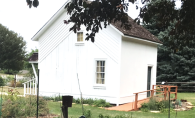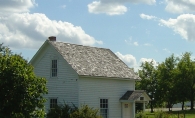Once a week from October through May, Project GO volunteers help third grade students turn a t-shirt into a pillow. Students learn how to do three stitches and complete a simple project. But it’s not really about the pillow. It’s about building community and forging intergenerational friendships.
Project GO—short for Grandparents Organized—aims to bring kids and senior citizens together in the classroom. The simple sewing project has become a well-loved tradition in third grade classrooms throughout South Washington County Schools/District 833. The South Washington Senior Center in Cottage Grove welcomes volunteers who live in Woodbury, St. Paul Park, Newport and Cottage Grove.
Marilyn Riggins began volunteering three years ago. She looks forward to meeting new students and finds their enthusiasm infectious. “These third graders are so anxious to learn and do things from themselves,” she says. Volunteers are encouraged to talk about their memories from third grade, which comes easily for Riggins, since she was in third grade when she first began learning how to sew. She eventually became a talented seamstress, making garments for her family members, including wedding gowns for her sisters, and eventually clothes for her own children.
Students love hearing how much things have changed, though it’s hard for them to imagine life without iPads, cell phones or electricity. Riggins says, “They’re kind of amazed” when she describes the one-room school house where she studied with 12 other students. “We even had a crank telephone,” she laughs. When a call came through, “It might not have been for me, but I still listened!”
Students are sometimes uncertain how to act around older adults, so when volunteers share vivid memories, it helps break the ice quickly. Volunteer Barbara Towler worked with a little boy who was new to the United States and still learning English. He was shy, so she told him about the chores she had to do when she was a third grader. It was her job to collect the eggs and wash them so her grandma could take them to town to sell. She described how she hated that job, especially when she had to scrub chicken poop off the eggs. Suddenly, he was laughing, relaxing and opening up. “The interaction is important,” she says, “especially when their grandparents are far away.”
Third grade has changed a lot since these seniors were in school. District 833 is full of diverse students from a variety of backgrounds, giving the volunteers plenty of new experiences themselves. Rosemarie Dahl has been volunteering with Project GO for 12 years, and each week brings a new classroom, a new student and a new adventure. “I’ve never traveled or anything, so with these kids from foreign countries, we talk the whole time,” Dahl says. “They tell us a lot of secrets and deep things.”
The experience sticks with both the volunteers and the students. Towler received a charming letter from Erena Belai, a student she worked with at Newport Elementary School, that warmed her heart. “You were always nice to me, thank you. You made my pillow look very good... Thank you Barbara, my pillow is strong and soft. I sleep in it sometimes. Barbara where are you right now? I want to know. Do you live in an apartment or a house? Write back a letter to me. Send it to the school, then write my name on it.”
Erena has three older siblings who have all made pillows of their own. Her brother Musie, 14, made a soft blue one. Her sister Arsema, 12, created one decorated with flowers. Her brother Alexander, 11, made a pillow covered with baseballs. Erena’s features Hannah Montana, made from a favorite t-shirt she’d outgrown.
Jackie Schroeder, social worker at Newport Elementary, says the kids hang on to their pillows for years. “When we have a movie day, the pillows all come back,” she says. Erena has some advice for the third graders who will make pillows this year. “Ask [the grandparents] some questions, and try your hardest, but if you lose it a little, the adult will help you,” she says.
Ultimately, the project is all about creating a wider community for both the students and the seniors. One-on-one connections are essential for kids and seniors alike. Schroeder believes that the more people in the school and community who participate, the better. “Our staff believes that we have to take care of our kids’ hearts before we teach them, and another adult in the school that knows your name, that can say ‘I’m glad you’re here,’ is just so important.” Dahl agrees. “We get just as much out of it as the kids. We all gain from having that hour together.”









